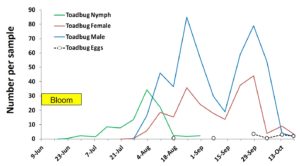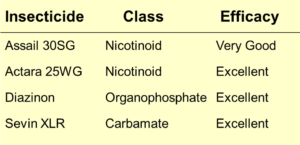Toad bugs, Phylloscelis atra, are an occasional pest of cranberries in New Jersey that can cause economic injury. This insect feeds only on

Fig. 1. Seasonal number of toad bug nymphs and adults per sweep net sample
cranberries and has a single generation per year. It overwinters as eggs. The nymphs appear by the end of June through early September, and the adults from end of July through October (harvest) (see Figure 1). Eggs are laid from end of August through October.
Damage. Feeding damage can be noticed in two stages. First stage feeding damage on vines causes closing in (towards the branch) of the leaves on the new growth. Second stage feeding causes changed in color (reddish to brown) of new growth. The damage can be seen from July until harvest. This damage will cause dying of the branch and the berries to shrivel up. Heavy infestation will result in dwarfed berries.
Management. To determine infestation, lightly sweep problematic beds (bugs should be easy to catch in sweep nets as they are very active). Because this is a new pest there is no threshold established yet. Thus, insecticide applications should be based on the relative number of bugs per sweep compared with other sites and previous history of infestation. Currently, growers can use the following control options: Sevin 4F (broad-spectrum carbamate), Diazinon (broad-spectrum organophosphate), or Actara or Assail 30SG (neonicotinoid insecticides, effective against piercing-sucking insects) (see Figure 2). If infestation is high, treatments should be applied when the nymphs are present (i.e., mid- to late-July; see Figure 1).

Fig. 2. Chemical control options for toad bugs
For more information, please see “The Cranberry Toad-Bug” by F.A. Sirrine and B.B. Fulton. 1914. New York Agricultural Experiment Station. Bulletin No. 377. Department of Agriculture, Geneva, NY.

